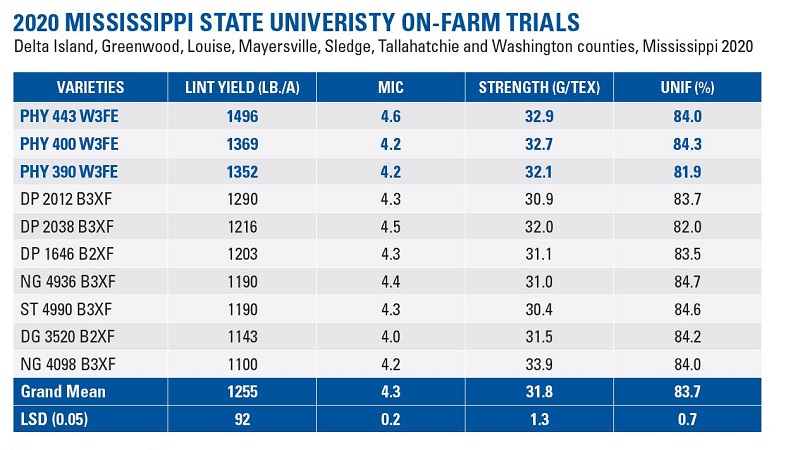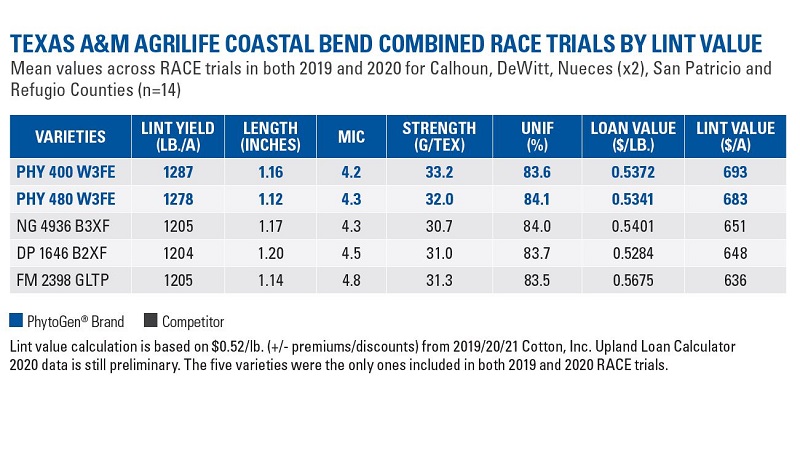New Data Shows PhytoGen® W3FE Varieties Yield Big Across the Cotton Belt

PhytoGen Cotton Development Specialist Tom Eubank, Ph.D., looks at the boll count of PhytoGen® brand PHY 443 W3FE at a trial location near Clarksdale, Mississippi in 2020. PHY 443 W3FE was the No. 1 variety in Delta locations of the 2020 Mississippi State University On-Farm Trials.
When making final variety decisions, cotton producers can gain an edge by reviewing yield data from multiple locations and seasons. While recent local data is most valuable, variety trials from similar geographies and spanning several years help to determine overall variety consistency.
Review data from several trials to get a clear picture, especially if you’re planting new varieties on your farm.
PhytoGen Cotton Development Specialist Tom Eubank, Ph.D., works with cotton producers to conduct variety trials throughout Mississippi. Excitement is building in his area as growers have reviewed data on newer PhytoGen® W3FE varieties.
“In the Delta, PhytoGen had the three highest-yielding varieties in the Mississippi State On-Farm Cotton Demonstration Trials in 2020,” Eubank said. “Our No. 1 variety yielded nearly 200 pounds higher than the closest competitor.”

PhytoGen® brand PHY 443 W3FE and PHY 400 W3FE led the 2020 Mississippi State University On-Farm Trials across seven Delta locations. Cotton agronomists recommend reviewing trial data from multiple locations when choosing varieties for your farm.1
That variety was PhytoGen brand PHY 443 W3FE, a new variety with built-in resistance to reniform and root-knot nematodes. Eubank said the variety’s genetic yield potential, combined with nematode resistance, make it an excellent choice for Midsouth producers, especially those with nematode issues.
“In my nematode trials last season, there was a night-and-day difference with PHY 443 W3FE compared to susceptible varieties planted on the very next row,” Eubank said. “In July and August, the susceptible plants were stunted and struggling, but PHY 443 W3FE was beautiful — the way cotton is supposed to look — loaded with bolls.”
PhytoGen brand PHY 400 W3FE, the No. 2 variety in the Mississippi State University On-Farm Trials, also had a big year across the Cotton Belt. It’s broadly adapted from the Midsouth to the Southeast and fits well in much of Texas and the greater Southwest.
PhytoGen Out-yields Competition in the Coastal Bend
In the Texas A&M AgriLife RACE trials in the Coastal Bend, PHY 400 W3FE had exceptional yield results two years in a row, ranking No. 1 in the combined 2019 and 2020 trials. It yielded 82 pounds more per acre than the closest competitor with a premium loan value.

PhytoGen® brand PHY 400 W3FE and PHY 480 W3FE outyielded competitors in the Texas A&M AgriLife Coastal Bend Combined RACE trials in 2019 and 2020.2
Brad Hopkins, Ph.D., is the PhytoGen cotton development specialist for south and central Texas. He said the combined two-year Texas A&M trials in his area demonstrate a consistency he’s also seen in PhytoGen Innovation Plots.
“When we review variety performance, we often look at combined data from two or three years because it gives us a better picture of variety performance,” Hopkins said. “Every season is different, and growers rarely have the perfect season — if that exists. By looking across years and locations, producers get a better idea of how varieties perform in the real world.”
PhytoGen Yields Big Across Several Seasons in the Southwest
PhytoGen Cotton Development Specialist Ken Lege, Ph.D., covers a large area spanning from West Texas to Oklahoma. He often encourages growers to look at data from two or three seasons to find consistent performers that will work best on their farms. He also pulls data from a larger area — sometimes Texas, Oklahoma and New Mexico — to gain even more perspective.
“The best trial data comes from your own backyard, but producers can learn a lot by looking outside their specific areas,” Lege said. “I tell producers not to limit themselves when it comes to data. It’s best to review multiple trials from several seasons to get the right varieties on your farm.”

PhytoGen Cotton Development Specialist Ken Lege recommends reviewing trial data from multiple years and a larger area, as shown above, to provide a more comprehensive picture of variety consistency.3
To that point, Lege said trial data is only part of the equation. Producers need to consider their soil type, pest pressure, water availability and other key factors before making variety decisions. He also recommends talking with PhytoGen cotton development specialists who have broader perspectives to help make those final decisions.
“PhytoGen cotton development specialists look at cotton fields and trial data all across the Cotton Belt,” Lege said. “We compare notes and share resources that producers can tap into. We’re here to help and just a phone call away.”
Find and contact your local PhytoGen cotton development specialist at PhytoGenCottonseed.com/team.
1Data derived from 2020 Mississippi State University On-Farm Cotton Demonstration Trials: Table 4. Yield and fiber quality data pooled over seven Delta locations. 2Data generated 11/20/20 and includes 14 trials with yield and fiber data from the Texas Coastal Bend from 2019-20. 3Data generated 11/25/20 and includes 32 trials for yield and 20 for fiber quality (proprietary and third party) with data from New Mexico, Oklahoma and Texas from 2018-20. Do not use this or any other data from a limited number of trials as a significant factor in product selection. Refer to your local PhytoGen representative for the latest and complete information.
™ ® Trademarks of Corteva Agriscience and its affiliated companies. © 2021 Corteva.



